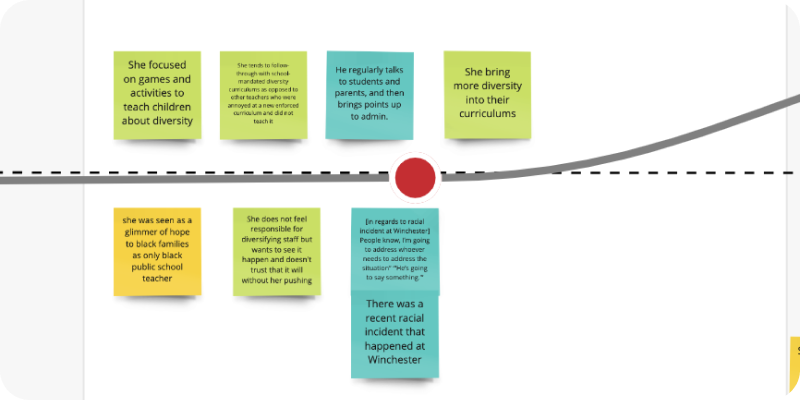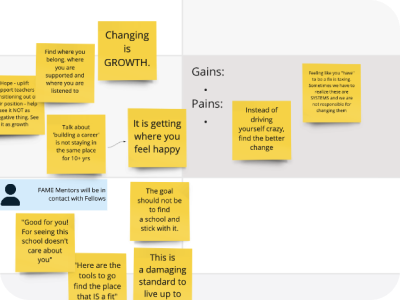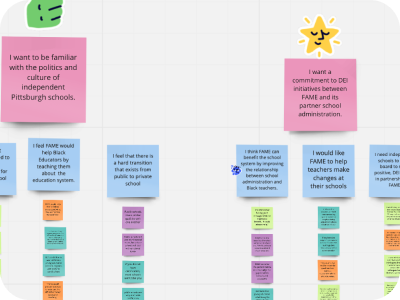To answer the question “Why do Black Educators leave the profession at a higher rate than other demographics?”, we needed to understand the landscape since none of us went to school in Pittsburgh before college, most of us did not attend private school, and none of us are Black. In short, we needed context.

In the first few months of our project, our team solely focused on conducting research into the education landscape of Pittsburgh and the experiences of everyone in it. From students, parents, teachers, administrators, and education technology professionals, we used our research phase to better understand the current landscape of Pittsburgh’s education space while also learning about how organizations like FAME fit into this ecosystem.
Our central goal was to address the question of why Black Educators leave the teaching profession at a higher rate than other demographics. To this end, we investigated systemic trends but also listened to the stories and day-to-day experiences of educators. As we started to overlap our research with our design process, we were much more focused on the day-to-day experiences of educators with the goal of isolating an area where we could help FAME intervene.
Our generative research involved field observations at community events with educators and with our client organization, FAME, as well as semi-structured interviews with a wide range of stakeholders. At this point, we saw that individual experiences of black educators vary widely, but there seemed to be common patterns or pitfalls that could lead to educators leaving the profession.
Through our 8 month exploration, we underwent numerous research methods and activities to better understand our problem space.
Combing through existing data with desk research
Before we even contacted our interview participants, we got to work by conducting inquiries into education and race via the Internet. This included searching for firsthand accounts on YouTube and Twitter, listening to existing discussions via podcasts and online panels, and reviewing the current literature and statistics about Black populations in school settings.
This desk research enabled us to mobilize our initial assumptions about the problem space. Although the tidbits we found covered a wide range of scholarly and colloquial understandings of the Black educator, a few notable sentiments bubbled to the surface. Our sources consistently highlighted a need for Black teachers to act as “mirrors” and role models for Black students. Speakers frequently brought up the disproportionately harsh scrutiny inflicted on Black students and educators.
Addressing a large influx of qualitative data by walking the wall
We did multiple walk-the-wall sessions in our lab space to find common themes in all we learned. For the casual interviews that contributed to this inquiry, we produced visual models of each participant's experience in education. We also included storyboards from various activities and materials discovered in desk research on our 'wall'.
In our wall walking sessions, we looked specifically for statements that were corroborated from multiple sources and statements that fit into similar categories. Ideas that had support from multiple sources inspired our high-level insights.
Better understanding participants lived experiences through directed storytelling
To better understand the career of Black educators, we conducted four “Journey Mapping Interviews” with Black Educators. These interviews involved the researcher and the participant working together to create a model of the educator's career journey.
To identify points in the journey representing career-defining decisions, we revisited previous interviews with former educators and considered what made them leave the classroom for good.
Mapping out the career of a Black educator to pinpoint the ‘pains’ they undergo
We conducted interviews where we asked participants to recount their journey as an educator while paying special attention to the early part of their career path.
We provided participants with a blank timeline that the researcher and the participant could fill in together to facilitate discussion. This resulted in back-and-forth engagement in which participants could better articulate their journey, correct interviewers when they misunderstood, and elaborate on key moments.
Through this exercise, we created a rudimentary journey map for each of our four participants. To arrive at high-level insights, we looked for common patterns in these four journeys and identified “breaking points.”
Finding themes in our participants' experiences by clustering initial findings
After conducting several interviews to validate our interactive model, we were left with many virtual post-its that were created in the context of stepping through the model phase by phase. We revisited these notes and looked for ideas that could apply to the whole journey or could stand alone as a finding.
We created an affinity diagram from these revised notes that combined findings from all our interviews. Engaging in this process allowed us to find recurring themes in our notes, and recognized that the insights that emerged were all needs that the teacher's academy has the potential to address.
To get firsthand accounts of the environment of partner schools, we did several drive-by visits of schools such as Shady Side Academy.
We used our lab space to physically lay out all the information we gathered in this phase of research.

For our walk the wall sessions, we printed out materials from various modeling activities or group ideation activities. We used post-its to leave notes on the wall and various materials to mark connections between items.

Marlon conducts a formal interview with a Black educator as they work together to create a journey map of the participants’ career journey through directed storytelling

Snippet view of a "breaking point" and notes gathered from an individual journey mapping session.

An example of our raw data from a single interview represented by ‘post its’ on our interactive model.

An excerpt from our affinity diagram, showing the groupings from which we drew insights.
With the goal of understanding the career trajectories of educators and finding these patterns, we began conducting what we called co-creation of artifacts with every teacher we spoke with. In these interviews, we would guide the teacher through creating a visual journey map of their career.
Through synthesizing these artifacts, we created a combined journey map that showed a path we believed every educator would see themselves in, and highlighted points at which educators would leave the profession.
Throughout nine phases of the journey map, we captured behaviors that were commonly associated in our interviews with those phases. Explore these behaviors by clicking on the minimap below.
Best viewed horizontally on mobile devices.
The core of our research was around why Black educators leave the profession more than other demographics. Our findings are partially represented by four systemic trends we identified as contributors. This is enhanced by the journey map modeling the career trajectory of black educators.
The education system, and society at large, has a model of how good students and good teachers behave, learn and teach. In many ways, this model of student and teacher does not account for cultural differences and socioeconomic divides. The pressure to assimilate into the education system that is not designed for Black educators is a contributing factor to why Black educators leave the classroom at a higher rate than educators in other demographics.
DEI training is critical for creating a safe environment for non-white students in general, but particularly Black students. The lack of training puts extra pressure on Black teachers at primarily white institutions (PWIs) because they are seen by their colleagues and students as the only ones who can provide psychological safety to Black students.
Black educators feel personally responsible for, and motivated by, their students' success. For a Black educator advocating for a minority group of Black students, seeing students be passed over and harmed by the education system can demotivate and guilt educators.
Lack of communication with administration can result in voices raised about equity in schools being met with hostility or indifference. Educators prefer to work at institutions where there is transparency with the administration, and where they are able to have open communication with their students' families. However, this value can take time to develop, and educators may not be able to seek this out intentionally early in their careers.
As a method of synthesis, our team utilized popular methods of analysis to uncover patterns and themes. While we initially set out to solely focus on Aspiring educators, we quickly realized there are two other stakeholders that directly influence the success an aspiring educator would have.
By expanding our focus to encompass these other influential stakeholders, we worked alongside each party to develop more of an understanding of their behaviors, needs, and ultimately, the opportunities to enhance their experience.
As a DEI administrator, Addy maintains their school's DEI policies, activities, training, and more.
Working in a FAME partner school as a DEI or related administrator.
Responsible for executing and revising DEI policies.
Meets with their school administration team to discuss training and efforts for DEI.
Understand DEI practices more than other administrators at their school, and are seen as the specialist.
No data about policy efficiency, because they don’t have a clear indication of how these policies are actually executed at their school.
Often feels like “lonely work” as they are the sole person with written responsibility to uphold DEI at their school.
Create an effective and robust DEI policy.
Communicate with school faculty and staff to improve DEI culture.
Conflict management when issues about DEI arise, either by abiding to or having conversations to improve their policy.
Has a background of teaching at schools in the Pittsburgh area, and finds themselves facing numerous struggles in their current position.
Experienced in teaching, as well as DEI work, policy, and/or concepts.
Able to critique DEI policy.
Has at least some experience teaching in schools
Not specific to any race.
Has limited time to spend.
If a minority, then they have experienced assimilation.
Teach classes.
Be there for the kids.
Ash is looking for their first teaching job and is interested in being informed of schools' DEI climates prior to the interview process.
They have yet to start their first teaching job.
Little to no experience teaching in schools.
Has no firsthand experience critiquing DEI policy.
Have the inclination/desire to critique policy but can’t articulate it, or feel less justified in critiquing it.
Takes policies at face value.
Uninformed view of schools prior to teaching there.
Doesn’t have the words to critique DEI policy.
Searching for the right school to start their career.
Understand the reality of what is happening in schools so they can inform their hiring decisions.